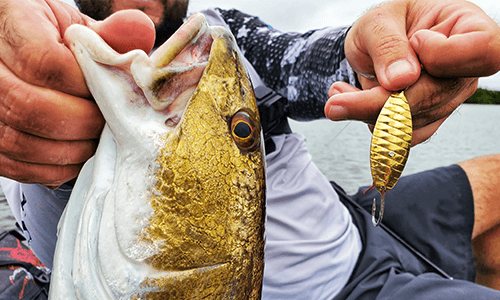The gold spoon is one of the most popular, dare I say one of the all-time top three, lures for redfish. Hardcore redfish anglers count these simple, unimpressive appearing chunks of metal because they not only produce large numbers of fish but big toads as well. But there is a bit more to catching fish on a gold spoon than directly tying one on and hitting your favorite spot- there is a bit of technique required. Let us help you get the most out of your gold spoon and the most fish in the boat.
Some anglers stray away from the spoon, favoring some of the scented options such as a Gulp! Shrimp on a jig head. While plastics, especially those that look and smell like natural prey, have a definite place in any tackle box. It should be right alongside a selection of gold spoons. Even if you regularly fish your creel with other lures, there are times when the fish will not cooperate, and switching it up can be just what the redfish ordered.

What Makes it So Unique?
Why does the gold spoon produce so many fish? Simple, it gives the fish what they all are searching for; the color and shape resemble the baitfish that they consume daily. The erratic vibrating action makes them think they are witnessing a wounded baitfish. They believe they see both a tasty meal and one that will be easier to catch. Plus, spoons are easy to cast, weedless and can be skipped into hard to reach spaces redfish like to call home.
Rigging
Rigging the spoon could not be easier. Attach a standard leader with a swivel between it and your mainline. That’s it. Pair it with a 7 ft medium-fast rod and your favorite spinning reel spooled in 15 lb. test, and you have a deadly combination.
A ¼ ounce spoon is perfect for when reds are feeding on baitfish, but if larger offerings are on the menu, bump up to the ½ version. Many users also find that a model that includes a red-colored hook to be more productive than a typical hook, either because it resembles a bloody wound or adds a bit more flash that attracts attention.
How to use your spoon
Spoons can produce fish in a wide range of conditions, but, like most lures, they're situations where it shines. Along weed lines, mangroves or similar structure should be your first targets as this is where redfish are most likely to congregate. Remember, reds like to travel in groups, so once you get a strike, don’t be too quick to look for a new spot. Repeated casts to the same area, or along the same retrieval path, will often produce multiple fish.
Because it is gold, these spoons are best suited for stained or dark water; if fishing clearer water, the same techniques can be used with a similar silver spoon. The weedless feature excels in those areas containing any potential snagging hazards- weeds, mangroves, oyster beds, or rocks. The shape of the spoon and hook guard combine to allow the lure to bounce off obstructions when other lures would be lost.
The erratic action is the key to the spoon’s success, but how you get that action is open to debate. Many anglers will cast and pause, allowing the spoon to flutter down to waiting fish. If you do not get a hit right off the bat, you have two options for the retrieve. A steady retrieve, varying speed based on conditions, will often draw fish out and even right to the boat. Others prefer to add a twitch to their retrieve, feeling it increased the motion even more. Try each, or mix it up, based on what the fish are responding, don't be afraid to try new techniques.
Conclusions
In closing, let's review why the gold spoon is one of the best lures for redfish.
- Cast well – allowing you to hit targets without moving as much or spooking fish
- Weedless – allows worry-free casting into areas where fish hide, but other lures get lost.
- Vibration – when combined with erratic movement, size, shape, and color it is almost irresistible
- Metal construction – will not be torn up by big fish requiring you to change lures when most successful.




